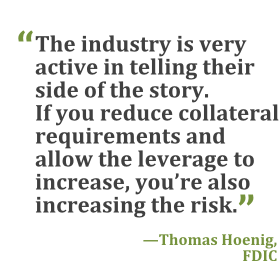Wall Street is making headway in a campaign to persuaderegulators to soften a key rule that has forced banks to boostcapital since the financial crisis.
|After financial firms complained for about a year that some ofthe new requirements will make it overly expensive to offerderivatives to clients, regulators planned to discuss possibleconcessions at a private meeting starting Wednesday, according totwo people with knowledge of the talks. The meeting consists ofpolicy advisers to a group of global authorities that includes theFederal Reserve, the European Central Bank (ECB), and the Bank ofEngland, the people said.
|The lobbying is tied to one aspect of how industry overseers setleverage ratios, which determine how much capital lenders need tooffset their risks. As the rules are now written, banks take a hiton the billions of dollars in collateral they receive fromcustomers for handling their derivatives trades.
| Regulatorsaround the world stiffened capital demands to make banks saferafter the 2008 market meltdown. Federal Deposit Insurance Corp.(FDIC) Vice Chairman Thomas Hoenig said easing the requirement forderivatives would undermine a rule meant to be a blunt tool tocurtail excessive risk-taking.
Regulatorsaround the world stiffened capital demands to make banks saferafter the 2008 market meltdown. Federal Deposit Insurance Corp.(FDIC) Vice Chairman Thomas Hoenig said easing the requirement forderivatives would undermine a rule meant to be a blunt tool tocurtail excessive risk-taking.
“The industry is very active in telling their side of thestory,” Hoenig said in an interview this week. “If you reduce thecollateral requirements and you allow the leverage to increase,you're also increasing the risk.”
|Wall Street banks dominate a list of the biggest derivativesbrokerages ranked by the amount of collateral posted by theirclients, according to data kept by the U.S. Commodity FuturesTrading Commission for futures and options trades.
|One clearing division of Goldman Sachs Group Inc. has US$22.6billion in customers' assets in segregated accounts, while a unitof JPMorgan Chase & Co. has $18.3 billion, according to theregulator's data as of June 30. The total derivatives-brokerageindustry has about $158 billion in segregated accounts.
|While Fed Chair Janet Yellen said last year that the leverageratio set to take effect in 2018 would limit “the damage that wouldbe done to our financial system if one of these firms were tofail,” bankers have criticized it as punishing them for holdinglow-risk assets.
|Collateral Rule 'Reduces Exposure'
|When U.S. banking agencies completed the leverage rule late lastyear, they rejected an industry bid to exclude collateral posted byclients when adding up each bank's total assets.
|Since its approval, groups representing banks, exchanges, andcommodity traders have pressed regulators to make changes. Theindustry says collateral, often cash or highly-rated bonds, is heldin segregated accounts that banks can't tap to finance riskytrading.
|“Including customer-segregated margin in the leveragecalculation ignores the fact that client margin actually reducesexposure for clearing member banks,” Jackie Mesa, executivedirector at the Futures Industry Association's FIA Global group,said in an email. “If customer segregated margin is included in theleverage ratio and subject to capital requirements, it will becomesignificantly more expensive to centrally clear trades.”
|Executives from derivatives-clearinghouse owners CME Group Inc.,Intercontinental Exchange Inc., and LCH.Clearnet Group Ltd. madesimilar comments to regulators in a comment letter last November.Their letter was also signed by the head of FIA, which representsJPMorgan, Goldman Sachs, and other banks that clear derivatives forclients.
|In a February presentation to investors, JPMorgan said capitalrules could lead to higher prices to clear derivatives and mightcause some brokerage firms to exit the market.
|The Commodity Markets Council, which represents Cargill Inc., BPPlc, and other commodity traders, has also warned regulators thatthe rule would increase costs by more than five times from currentlevels.
|The industry has found an ally in Timothy Massad, chairman ofthe CFTC, who has said the added costs may deter banks fromprocessing client trades through clearinghouses. Massad beentalking with other regulators to prepare a response.
|The policy group meeting this week advises the Basel Committeeon Banking Supervision. Industry lobbyists have pushed the BaselCommittee to change how the leverage ratio is calculated. Emailsseeking comments from the Basel Committee and the Bank forInternational Settlements went unanswered this week.
|Hoenig said granting an exemption for derivatives collateralcould set up a slippery slope and encourage future exclusions thatdamage the intent of the leverage rule.
|Copyright 2018 Bloomberg. All rightsreserved. This material may not be published, broadcast, rewritten,or redistributed.
Complete your profile to continue reading and get FREE access to Treasury & Risk, part of your ALM digital membership.
Your access to unlimited Treasury & Risk content isn’t changing.
Once you are an ALM digital member, you’ll receive:
- Critical Treasury & Risk information including in-depth analysis of treasury and finance best practices, case studies with corporate innovators, informative newsletters, educational webcasts and videos, and resources from industry leaders.
- Exclusive discounts on ALM and Treasury & Risk events.
- Access to other award-winning ALM websites including PropertyCasualty360.com and Law.com.
*May exclude premium content
Already have an account? Sign In
© 2024 ALM Global, LLC, All Rights Reserved. Request academic re-use from www.copyright.com. All other uses, submit a request to [email protected]. For more information visit Asset & Logo Licensing.







